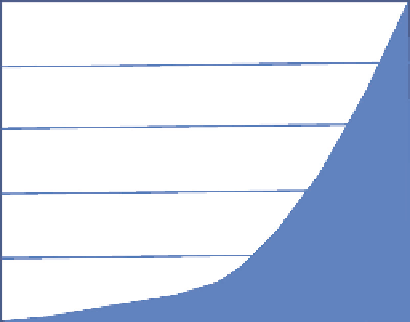Environmental Engineering Reference
In-Depth Information
17.5 AQUATIC PLANT MANAGEMENT
Aquatic plants refer to the macrophytes or the “larger” (macro) vascular plants. These include emer-
gent, submersed (submerged aquatic vegetation [SAV]), and free-loating forms. As with algae,
these organisms form the base of the food chain. In addition, they provide a substrate on which
other organisms can grow (e.g., the microbiota), provide shelter and an escape habitat for organ-
isms, impact lows, impact nutrient cycling and sediment chemistry, and impact other limnological
characteristics of lakes. Horne and Goldman (1994) indicated that emergent reeds and submerged
macrophytes are the dominant primary producers and contribute the most biomass in small lakes.
Also, as with algae, the excessive growth of macrophytes can cause a wide variety of problems, such
as limiting swimming and other recreational activities, affecting navigation, shading other species,
increasing sedimentation, causing oxygen depletion, and other impacts. In many southern lakes and
reservoirs in the littoral zone, they can completely cover the lakes surface during the summer months.
Many of the real “problem children” of the macrophytes are also invasive species, such as the Eurasian
water milfoil, which infest a wide variety of lakes and reservoirs and can grow at incredible rates.
The methods for the control or, in the case of invasive species, the eradication of macrophytes
have traditionally consisted of either cutting or herbicide usage. However, there are a wide variety
of alternative methods in common use, such as those listed and briely discussed next.
•
Prevention
•
Benthic barriers
•
Dredging
•
Mechanical removal
•
Water level control
•
Herbicide usage
•
Biological controls
17.5.1 p
reVentIon
The prevention of the spread of aquatic plants, particularly invasive species, is a common and cost-
effective part of weed control programs in many states. It is cost effective since it focuses on the initial
phase of invasion when costs are least (Figure 17.6) and it produces longer-lasting results than those
500
400
300
200
100
Introduction
Establishment phase
Displacement
FIGURE 17.6
Comparison of invasion phase versus management costs. (After Chilton, E.W., Aquatic veg-
etation management in Texas: A guidance document, Texas Parks and Wildlife, Inland Fisheries, San Marcos,
T X, 20 0 4.)

Search WWH ::

Custom Search